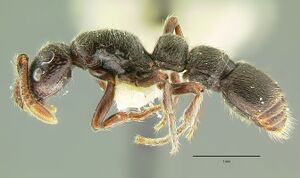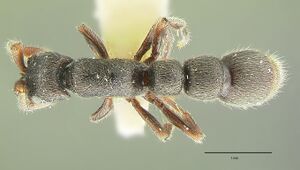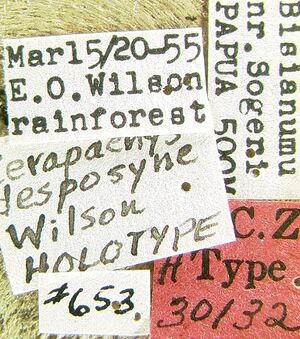Parasyscia desposyne
| Parasyscia desposyne | |
|---|---|

| |
| Scientific classification | |
| Kingdom: | Animalia |
| Phylum: | Arthropoda |
| Class: | Insecta |
| Order: | Hymenoptera |
| Family: | Formicidae |
| Subfamily: | Dorylinae |
| Genus: | Parasyscia |
| Species: | P. desposyne |
| Binomial name | |
| Parasyscia desposyne (Wilson, 1959) | |
Identification
Distribution
Latitudinal Distribution Pattern
Latitudinal Range: 9.421° to -7.734722222°.
| North Temperate |
North Subtropical |
Tropical | South Subtropical |
South Temperate |
- Source: AntMaps
Distribution based on Regional Taxon Lists
Indo-Australian Region: New Guinea (type locality).
Distribution based on AntMaps
Distribution based on AntWeb specimens
Check data from AntWeb
Countries Occupied
| Number of countries occupied by this species based on AntWiki Regional Taxon Lists. In general, fewer countries occupied indicates a narrower range, while more countries indicates a more widespread species. |

|
Estimated Abundance
| Relative abundance based on number of AntMaps records per species (this species within the purple bar). Fewer records (to the left) indicates a less abundant/encountered species while more records (to the right) indicates more abundant/encountered species. |

|
Biology
Castes
   
| |
| . | Owned by Museum of Comparative Zoology. |
Nomenclature
The following information is derived from Barry Bolton's Online Catalogue of the Ants of the World.
- desposyne. Cerapachys (Cerapachys) desposyne Wilson, 1959b: 45 (w.) NEW GUINEA (Papua New Guinea).
- Type-material: holotype worker, 1 paratype worker.
- Type-locality: holotype Papua New Guinea: Bisianumu, nr Sogeri, 500 m., no. 658 (E.O. Wilson); paratype with same data.
- Type-depository: MCZC.
- Combination in Parasyscia: Borowiec, M.L. 2016: 204.
- Status as species: Brown, 1975: 22; Bolton, 1995b: 142.
- Distribution: Papua New Guniea.
Description
References
- Bolton, B. 1995b. A new general catalogue of the ants of the world. Cambridge, Mass.: Harvard University Press, 504 pp. (page 142, catalogue)
- Borowiec, M.L. 2016. Generic revision of the ant subfamily Dorylinae (Hymenoptera, Formicidae). ZooKeys 608: 1-280 (doi:10.3897/zookeys.608.9427).
- Chen, Z., Liang, C., Du, C. 2022. Revision of Chinese species of the ant genus Parasyscia Emery, 1882 (Hymenoptera: Formicidae: Dorylinae). Zootaxa 5196(3), 301–330 (doi:10.11646/zootaxa.5196.3.1).
- Wilson, E. O. 1959d. Studies on the ant fauna of Melanesia. VI. The tribe Cerapachyini. Pac. Insects 1: 39-57 (page 45, worker described)
References based on Global Ant Biodiversity Informatics
- Borowiec M. L. 2016. Generic revision of the ant subfamily Dorylinae (Hymenoptera, Formicidae). ZooKeys 608: 1–280.
- Brown W. L., Jr. 1975. Contributions toward a reclassification of the Formicidae. V. Ponerinae, tribes Platythyreini, Cerapachyini, Cylindromyrmecini, Acanthostichini, and Aenictogitini. Search Agric. (Ithaca N. Y.) 5(1): 1-115.
- Janda M., G. D. Alpert, M. L. Borowiec, E. P. Economo, P. Klimes, E. Sarnat, and S. O. Shattuck. 2011. Cheklist of ants described and recorded from New Guinea and associated islands. Available on http://www.newguineants.org/. Accessed on 24th Feb. 2011.
- Klimes P., P. Fibich, C. Idigel, and M. Rimandai. 2015. Disentangling the diversity of arboreal ant communities in tropical forest trees. PLoS ONE 10(2): e0117853. doi:10.1371/journal.pone.0117853
- Lucky A., K. Sagata, and E. Sarnat. 2011. Ants of the Nakanai Mountains, East New Britain Province, Papua New Guinea, Chapter 1. In Richards, S. J. and Gamui, B. G. (editors). 2013. Rapid Biological Assessments of the Nakanai Mountains and the upper Strickland Basin: surveying the biodiversity of Papua New Guineas sublime karst environments. RAP Bulletin of Biological Assessment 60. Conservation International. Arlington, VA.
- Snelling R. R. 1998. Insect Part 1: The social Hymenoptera. In Mack A. L. (Ed.) A Biological Assessment of the Lakekamu Basin, Papua New Guinea, RAP 9. 189 ppages
- Wilson E. O. 1959. Studies on the ant fauna of Melanesia. VI. The tribe Cerapachyini. Pacific Insects 1: 39-57.

